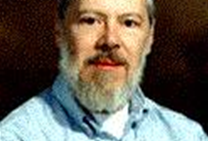Techies are by nature a little different from the rest of the population.
Some of the people on this list are successful billionaires, Some Nobel prize winners or high-tech nomads. However, some individuals are weird even by geek standards.
Those who made this week's top 10 list have managed to not only be hugely successful in the business, but also generate some great stories of oddball behaviour.
Honourable mention: Thomas Dolby
Shaun Nichols: Not too many tech executives can also lay claim to a hit song and landmark video.
Most people know Thomas Dolby only as the man behind the early 80s new wave hit "She Blinded Me With Science." When not creating or producing fodder for MTV, however, Dolby has in fact been a very influential character.
In 1993, Dolby started a small digital music outfit called Headspace. As the web took off, the company developed the RMF music format and the Beatnik browser plug-in. The company now known as Beatnik is an established developer of music software for PCs and mobile phones.
Dolby has proven to be both a musical and technological visionary. Certainly an odd, if not wonderful combination.
Iain Thomson: I'll give you this one Shaun, but not for the horrifyingly bad "She Blinded Me With Science."
I've a soft spot for Mr Dolby because he did a lot of good work on Def Leppard's seminal 1983 album Pyromania, under the name Booker T. Boffin. He did get sued by Ray Dolby, inventor of Dolby noise reduction and co-inventor of the video tape, who coincidentally has a son called Thomas.
I can't help thinking that the internet needs more rock stars, especially those who care enough about music to create their own format.
Honourable mention: Steve Ballmer
Iain Thomson: I can't decide if Ballmer's genuinely weird or it's all just an Uncle Fester impression, put on to freak people out.
His conference exhortations have gained him an amused following and there were moves at the UK launch of Windows XP to get the crowd chanting “Do the dance monkeyboy!” but sadly people chickened out.
There have been reports that the wild Man of Microsoft dismembers office furniture in fits of temper and he is apparently a very tough man to face over a board room negotiation. This is what makes me think that he's acting up – when he starts to sweat and get bulgy eyed there's still plenty of people who aren't willing to take the risk that he won't vault over the table and sink his teeth into their throats.
Shaun Nichols: One can never accuse Steve Ballmer of lacking passion. From the aforementioned "Monkeyboy" dance to the enraged "developers developers developers" mantra, Ballmer has given us some classic YouTube clips.
When you get down to it, however, there are few people I would rather have running a large tech firm than Ballmer. He may seem a bit like Uncle Fester on a three day speed binge, but he also runs a pretty tight and well-oiled ship at Microsoft. It is said that Windows Vista was Bill Gates baby, but Windows 7 is Steve Ballmers' baby. Given how smoothly Windows 7 development and rollout has gone, and given what a disaster Vista turned out to be, one has to give a tip of the hat to the Ballmer way of doing things.
Yes, Microsoft has had some clunkers as of late, but that is more due to years of sloppy practice and bloated software that had little to do with the CEO. Even with the company in the worst situation it has seen in years, it seems a great many Microsoft employees still hold a firm belief in the company, and a lot of that has to do with Ballmer.
10. John Perry Barlow
Shaun Nichols: Okay, so I guess Thomas Dolby isn't the only one who can claim a hit song and a major IT outfit.
Alternately described as a lyricist, activist, anarchist and libertarian, John Perry Barlow has done a great many things in his quest to bring freedom and openness to the world.
The one project that endears him in our hearts, however, is his work for online freedom. In 1990, Barlow was one of three activists that helped to establish the Electronic Frontier Foundation. Since the early days of the internet, the EFF has been on the forefront of the battle for user rights. The group has launched extensive legal campaigns against everything from DRM to heavy-handed use of the Digital Millennium Copyright Act.
Not bad for a guy best-known for co-writing Grateful Dead hits.
Iain Thomson: John Perry Barlow was a nightmare for people whose default conversational gambit is “So what do you do?”
His career spanned animal husbandry, Grateful Dead writer, rancher and social activist.
Steve Jobs once reportedly said that Bill Gates would be a broader person if he'd dropped acid. Barlow seems to have got that out of the way first, along with heroic doses of Wild Turkey with fellow Grateful Dead members for over a decade before discovering the Well in 1986, the very dawn of the internet community movement. He brought a little rebel attitude to the web, and left a lasting mark.
Since then his co-invention, the EFF, has been in the vanguard of protecting our online freedoms. It keeps companies and governments honest and is willing to fight for the rights of computer users everywhere.
9. William Shockley
Iain Thomson: The co-inventor of the transistor was a difficult man to work for, and had some distinctly odd ideas about the human race.
Shockley was one of the three men behind the invention of the transistor at Bell Labs, work for which they shared a Nobel Prize. But he was reputedly so abrasive to work for that he was passed over for promotion and left to use his skills to set up Shockley Semiconductor Laboratory, America's first semiconductor firm based in Mountain View, California.
The new company didn't change his management style and he annoyed staff due to paranoid fears that his inventions were being stolen. At one point everyone in the company had to take a lie detector test to prove their loyalty. This riled many staff and the so called 'Traitorous Eight' left and started Fairchild Semiconductor, which begot Intel.
Later in life he became devoted to the subject of genetics. He believed that humanity was doomed if people of low intelligence reproduced more than clever people and advocated paid sterilisation for anyone with an IQ lower than 100. When he sued for libel after the accusation that he was 'Hitlerite' he won, but was awarded just one dollar in damages. He even donated sperm to a Noble Prize sperm bank so his genes could be passed on.
In the end he died a lonely, embittered man, estranged from most of his family, a sad end for one of the pioneers of Silicon Valley.
Shaun Nichols: One thinks that Shockley and Steve Jobs might have hit it off rather well.
Many of the people on our list either overcame or leveraged their oddball status to become very successful in business and happy in life. This was not the case with Shockley.
His controlling ways and paranoid point of view drove away many of his employees. One can only imagine how huge Shockley Semiconductor would have been had he not alienated his most talented engineers. Even Steve Jobs and Larry Ellison have the good sense to keep their best talent happy, and so within company walls.
In the end, Shockley's eccentricity was his greatest liability, not his greatest asset.
On another note, his views on stupid people reproducing sound a lot like the plot for the Mike Judge film "Idiocracy," perhaps someone at the Shockley Estate should give the lawyers a call...
8. Charles Simonyi
Shaun Nichols: So who among us didn't at one time or another dream of becoming an astronaut? Hungarian-born software icon Charles Simonyi got to live that dream, even if it was a little later in life than he had imagined.
Simonyi emerged from Eastern Europe to attend college in California and later join the Xerox Palo Alto Research Center in the late 70s. In 1981 he was hired by Microsoft and helped lead the development of Word and Excel. This of course endowed Simonyi with enough money to buy and sell all of us several hundred times over.
But that's not all. In 2006, Simonyi decided to leave his sizeable bank account, ground-breaking software firm and 28 year-old Swedish millionaire wife behind here on Earth and hitch a ride to the International Space Station.
Okay, so maybe it's not "strange" so much as "really, really cool," but there's no doubt that Simonyi is very much a one-of-a-kind person.
Iain Thomson: By the Pratchett definition Charles Simonyi is not strange; he's eccentric. It's like strange, but with a lot more money.
As a programmer he developed the idea of a master infrastructure to code development. A central designer would show the goal and coders could noodle around so long as they achieved it in the most efficient manner possible. Also, by developing a central architecture, Simonyi made applications development much more efficient.
But he had his moments. He's the only time return visitor to the International Space Station, spends much of the year on his custom-built yacht and threw over a fifteen year relationship with Martha Stewart for a Swedish girl under half his age.
That said, he's also founded the Simonyi Professorship of the Public Understanding of Science at Oxford University (first holder: Richard Dawkins), so maybe a little oddness isn't too bad.
7. Seymour Cray
Iain Thomson: Silicon Valley is a wonderful place to live and do business, or so millions of people seem to think. However, for Seymour Cray, it was just too full so the father of supercomputing was happier in Chippewa Falls, Wisconsin.
He spent the Second World War in Europe and supporting the Philippino Guerilla army in the Far East. He then came back, got a degree and set about changing the way we build and design computers. For decades later in life the name Cray would be synonymous with high performance computing.
He was by all accounts an odd person to work for. He was brilliantly inspired, but insisted on an absolutely quiet workplace and part of his move to Wisconsin was to get away from customers who kept disturbing his work. The other was reputed to be a fear of nuclear war.
Cray was also something of a loveable oddball. He claimed once that his skills were given to him by the elves, he dug tunnels to relax and was a talented windsurfer. But what makes him special for me is his single-minded purpose and his willingness to walk away so he could do things his way.
Shaun Nichols: Some people spend their downtime at work cruising Fark.com or catching up on the latest celebrity gossip. Seymour Cray used to sit at his desk and design logic circuits.
He was so focused that as soon as he was able to run his own facility, he promptly moved the entire operation from the hustle and bustle of Minneapolis, Minnesota and into the frozen forests far outside of town so that he would be able to work free from the reach of those pesky management types and get some peace and quiet.
The results speak for themselves. Cray was one of the driving forces behind the development of the supercomputing field, and many of his designs remained in use for decades. His Cray I and Cray II supercomputers both sent shockwaves throughout the industry, the later holding the top speed ranking for five years.
Personally he was also rather remarkable. An electronics genius since early childhood, he also possessed business savvy and an uncanny knack for setting off on his own when he first formed Cray Research and Cray Computer Corporation (though the latter went bankrupt after the end of the Cold War deflated the supercomputer industry.)
6.Gary McKinnon
Shaun Nichols: Okay, not to disparage Mr. McKinnon or make light of his legal struggle, but the guy is a little weird.
It's one thing to believe in UFOs and government conspiracies. It's another to actively seek out government documents which prove it. And it's a completely different level to then hack into NASA computers in order to obtain evidence that aliens have landed on Earth.
That's not to say we [V3] aren't huge fans of Gary McKinnon and strong supporters of his cause. That the US government would put so much effort and malice into charging McKinnon for his actions is completely absurd.
For those who would preach about bringing a criminal to justice, I say that as an American citizen I am far less concerned about charging a non-destructive computer criminal than I am about the fact that the US military had dozens of its systems compromised by a systems administrator from Glasgow looking for photos of little green men.
Perhaps rather than sending McKinnon to jail, the government should put him to work teaching network security to its own IT admins.
Iain Thomson: Despite attempts to portray McKinnon as a master hacker the facts show that this was simply an odd character who got lucky.
By some accounts McKinnon got into highly classified US military accounts just by typing admin into the password box. The admission that the US Navy was still using Windows NT4 was even more shocking.
I've met McKinnon and he's nothing more than a skilled script kiddie. By all accounts he entered these networks just to search for evidence of ETs. The fact he had any damage seems down to ineptitude rather than ill-will.
Read on to page two for the top five!




















